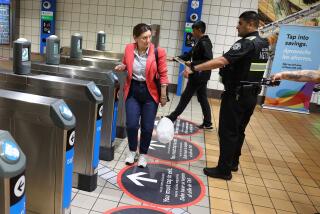D.C. taxis must switch from zone system to time, distance
- Share via
WASHINGTON — The District of Columbia will join the nation’s other major cities by installing meters in its taxis, abandoning a quirky zone system that has frustrated residents and visitors alike for decades, the mayor announced Wednesday.
Facing a deadline imposed by Congress, Mayor Adrian M. Fenty opted to require that taxis in the nation’s capital calculate fares using time and distance meters instead of the zone system.
Under the zone system, which Congress established during the Depression, fares are determined based on a map of 23 zones -- a downtown core with 22 other sections radiating outward. The fare is based on how many zones the taxi travels through to get to its destination.
Critics have complained that the system is complicated and vulnerable to cheating, but drivers have fought the switch. The head of one cab company said Wednesday that the decision would lead to a loss of business.
Mary Strain, a New York City resident who makes frequent trips to Washington, said she would rather have meters.
“It’s a pain in the neck if you’re only going a few blocks,” she said, after arriving by train at Union Station earlier this week. “And if you don’t know the city, you don’t know where the zone boundaries are.”
Washington is the only major city in the country without meters in its cabs. Fenty was forced to make a decision by Wednesday under a provision written by Sen. Carl Levin (D-Mich.), a longtime proponent of meters. Like many, Levin described repeatedly being charged different fares for the same trip.
Fenty said his administration would work with the D.C. Taxicab Commission on a timeline and transition plan.
“As we work to become a world-class city, it is essential that all aspects of district government are user-friendly, fair and efficient for residents and visitors alike,” he said.
He said his decision was based on resident, tourist and hospitality industry input.
Speaking Tuesday before the announcement, Bill Hanbury, Washington, Convention and Tourism Corp. president, said switching to meters would make the city “a better destination.”
But the taxi industry has been the strongest opponents of meters, fearing that stricter regulation will lead to loss of business and squeeze out independent operators.
“We’re extremely disappointed in the decision,” said Roy Spooner, general manager of Yellow Cab Co. of D.C. Inc. “We do not believe it is in the best interest of residents or drivers.”
Yellow Cab had offered the city a third option -- a zone meter. The company recently outfitted 100 cabs with a zone-fare calculator that uses Global Positioning Systems to track movement between zones and provides the customer with a detailed receipt.
“We agree that you should meter taxis, that’s why we developed that technology,” Spooner said. “But when you go to time-and-distance in a city that is prone to gridlock and traffic congestion, the people who live further away will pay more money,” causing a loss in ridership.
He said that while drivers would continue to provide service, many felt slighted by the mayor’s process.
“We developed the zone meter to give the city an alternative to solve their zone problem, and he completely ignored it.”
More to Read
Sign up for Essential California
The most important California stories and recommendations in your inbox every morning.
You may occasionally receive promotional content from the Los Angeles Times.










